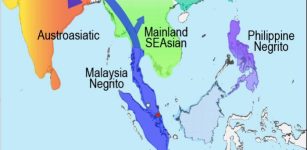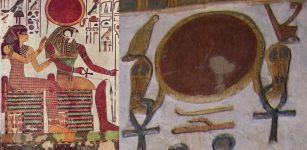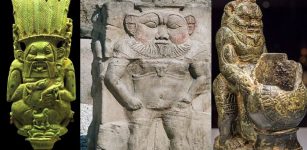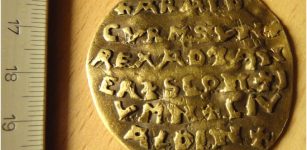The Incas Used Stringy Objects Called ‘Quipus’ To Record Data – We Just Got A Step Closer To Understanding Them
AncientPages.com - For more than a millennium, many Andean peoples used an object called a "khipu" (also spelled "quipu" and pronounced "key-poo") to record and communicate information.
Khipus were made with cords or strings with knots tied into them. And experts understand that many, but not all, of these knots were used to represent numbers.
Khipus used coloured cords adorned with knots at specific points. Jack Zalium/flickr, CC BY-SA
In a new study, I make a numeric connection between two important khipus from history—the first being being the largest khipu ever known and the other one of the most complex.
What were khipus used for?
While khipus were used in earlier times, they were especially important to the Inca Empire, which lasted from around 1438 CE to 1532 CE (when the empire was conquered by the Spanish). Since the Inca did not leave any written records, khipus are understood to have been their main system of communication and record-keeping.
Khipus were commonly made from either cotton or fibers sourced from camelids (the group of animals that includes camels, llamas and alpacas). These materials could be dyed or left naturally colored. Some khipus even include plant fibers, while several incorporate human hair.
It seems specially-trained khipu makers ("khipukamayuqs") made very deliberate decisions when constructing these record-keeping tools. These decisions related to the colors used, the direction of spin and ply of the cord fibers, the spacing and type of the cord attachments, and the structure and position of the knots.
Early Spanish chroniclers wrote about the khipu's various numeric applications, which included recording storehouse inventories, population censuses and tax and tribute obligations.
A new numeric connection
For more than a century, researchers have been studying khipu features in hopes that patterns may emerge from a collective view. In recent decades, their data have been digitized, which is now freely available via the Open Khipu Repository and the Khipu Field Guide.
For my research, I analyzed the data from two khipus found in northern Chile and first recorded by ethno-mathematician Marcia Ascher and anthropologist Robert Ascher in the 1970s. One of these is the largest khipu ever found—spanning more than five meters in length and comprising more than 1800 cords. The other khipu (pictured in the header image) has almost 600 cords in complicated arrangements.
I noticed both khipus used red/white "divider" cords to separate groups of either tens or sevens. The larger khipu was divided into ten groups, with each group having seven cords. The smaller khipu was divided into seven groups, with each group having ten cords (and many subsidiary cords).
After examining and manipulating the data, I realized the smaller and more complex khipu is a summary and reallocation of the information in the larger khipu. In other words, the two khipus record the same data, but represent it differently.
This is the most complicated numeric connection between khipus made to date. It was only possible because of the availability of data and digital tools that make searching for patterns easier—and which wouldn't have been available to Marcia Ascher back in the 1970s.
New khipu clues
While the numbers in these two khipus are counting and allocating something, we don't yet know what that was. Why would it be necessary to have two khipus recording the same information in two different ways? We can only speculate.
Perhaps the larger khipu recorded the collection of different amounts of food crops from the community, while the other recorded how these foods were distributed between those in need, or between storehouses. Both ways of looking at the numbers would have been important to the people who used these khipus.
Experts believe only a tiny fraction of the khipus made throughout history have survived. This is partly because the institutions that used them eventually either became obsolete or used other means of recording after the conquest, combined with a climate that was less than ideal for textile preservation.
Today, about 1,600 khipus remain, residing mainly in collections in the Americas and Europe. Fewer than half of these have had their features digitally saved in research databases.
Through continued digitization efforts, we hope to discover more khipu clues—and make new numeric connections that add to our understanding of ancient Andean peoples.
Provided by The Conversation
This article is republished from The Conversation under a Creative Commons license. Read the original article.
More From Ancient Pages
-
 Cities Of Bashan Were Built By Ancient Giants – Archaeological Evidence Exists But Is Ignored
Biblical Mysteries | Nov 25, 2020
Cities Of Bashan Were Built By Ancient Giants – Archaeological Evidence Exists But Is Ignored
Biblical Mysteries | Nov 25, 2020 -
 Ponte di Cecco – Legend Of A Bridge Built By An Astrologer With The Help Of The Devil
Featured Stories | Aug 19, 2021
Ponte di Cecco – Legend Of A Bridge Built By An Astrologer With The Help Of The Devil
Featured Stories | Aug 19, 2021 -
 Hadrian’s Wall: North-West Frontier Of The Roman Empire For Nearly 300 Years
Featured Stories | Sep 1, 2020
Hadrian’s Wall: North-West Frontier Of The Roman Empire For Nearly 300 Years
Featured Stories | Sep 1, 2020 -
 Templo Mayor – Sacred Aztec Complex Dedicated To Gods Tlaloc And Huitzilopochtli Who Were Usually Appeased With Human Sacrifices
Featured Stories | Jan 23, 2018
Templo Mayor – Sacred Aztec Complex Dedicated To Gods Tlaloc And Huitzilopochtli Who Were Usually Appeased With Human Sacrifices
Featured Stories | Jan 23, 2018 -
 AI Discovers Hundreds Of Unusual Nazca Geoglyphs In The Desert
Places | Oct 7, 2024
AI Discovers Hundreds Of Unusual Nazca Geoglyphs In The Desert
Places | Oct 7, 2024 -
 Secrets Of The Jungle And Hidden Ancient Treasures Of The Serpent People
Ancient Mysteries | Feb 29, 2020
Secrets Of The Jungle And Hidden Ancient Treasures Of The Serpent People
Ancient Mysteries | Feb 29, 2020 -
 Prehistoric Human Migration In Southeast Asia Driven By Sea-Level Rise – Study Reveals
Archaeology | Feb 6, 2023
Prehistoric Human Migration In Southeast Asia Driven By Sea-Level Rise – Study Reveals
Archaeology | Feb 6, 2023 -
 Catastrophic Final Flooding Of Doggerland By The Storegga Tsunami – New Study Results
Archaeology | Dec 2, 2020
Catastrophic Final Flooding Of Doggerland By The Storegga Tsunami – New Study Results
Archaeology | Dec 2, 2020 -
 Cleveland’s Prehistoric Sea Monster Had A Mouth Twice As Large As A Great White Shark
Fossils | Mar 3, 2023
Cleveland’s Prehistoric Sea Monster Had A Mouth Twice As Large As A Great White Shark
Fossils | Mar 3, 2023 -
 Hidden Ancient Underground Tomb Discovered In Petra May Solve The Mystery Of The Nabataean Kingdom
Places | Oct 18, 2024
Hidden Ancient Underground Tomb Discovered In Petra May Solve The Mystery Of The Nabataean Kingdom
Places | Oct 18, 2024 -
 Eye Of Ra – Powerful Ancient Egyptian Symbol With Deep Meaning
Ancient Symbols | Jan 23, 2019
Eye Of Ra – Powerful Ancient Egyptian Symbol With Deep Meaning
Ancient Symbols | Jan 23, 2019 -
 Mysterious Massive 3,800-Year-Old Structure And Passageway Found In The Jezreel Valley, Israel
Archaeology | Aug 23, 2023
Mysterious Massive 3,800-Year-Old Structure And Passageway Found In The Jezreel Valley, Israel
Archaeology | Aug 23, 2023 -
 Neanderthals’ Lack Of Drawing Ability Could Explain Why Modern Humans Became Smarter
Archaeology | Feb 11, 2018
Neanderthals’ Lack Of Drawing Ability Could Explain Why Modern Humans Became Smarter
Archaeology | Feb 11, 2018 -
 Is Legendary Celtic Warrior Queen Medb Buried In An Ancient Mound On The Top Of Knocknarea?
Celtic Mythology | Jan 24, 2021
Is Legendary Celtic Warrior Queen Medb Buried In An Ancient Mound On The Top Of Knocknarea?
Celtic Mythology | Jan 24, 2021 -
 Bes – Ancient Egyptian Dwarf God Of Childbirth, Humor, Song and Dance
Egyptian Mythology | Sep 9, 2016
Bes – Ancient Egyptian Dwarf God Of Childbirth, Humor, Song and Dance
Egyptian Mythology | Sep 9, 2016 -
 Tricksters: Mischievous Troublemakers Making Attempts To Help And Hinder In Mythologies Of Ancient Cultures
Featured Stories | Oct 28, 2019
Tricksters: Mischievous Troublemakers Making Attempts To Help And Hinder In Mythologies Of Ancient Cultures
Featured Stories | Oct 28, 2019 -
 On This Day In History: Leon Trotsky Was Assassinated – On August 20, 1940
News | Aug 20, 2016
On This Day In History: Leon Trotsky Was Assassinated – On August 20, 1940
News | Aug 20, 2016 -
 10 Enigmatic Ancient Underwater Ruins – Our Oceans Are Full Of Secrets
Featured Stories | Aug 13, 2019
10 Enigmatic Ancient Underwater Ruins – Our Oceans Are Full Of Secrets
Featured Stories | Aug 13, 2019 -
 Mysterious Golden Curmsun Disc And Its Connection To King Harald Bluetooth And The Legendary Jomsvikings
Artifacts | Apr 13, 2022
Mysterious Golden Curmsun Disc And Its Connection To King Harald Bluetooth And The Legendary Jomsvikings
Artifacts | Apr 13, 2022 -
 How Extensively Did Early Farmers Utilize Europe’s Rich Forests For Raising Their Livestock?
Archaeology | Nov 13, 2024
How Extensively Did Early Farmers Utilize Europe’s Rich Forests For Raising Their Livestock?
Archaeology | Nov 13, 2024

